
Pine City, Minnesota
by Ronald D. Kness
Located along the Snake River, one and a half miles west of present-day Pine City in northern Minnesota, sits a recreated 1804 wintering fur post of the Northwest Company. During the early 1800s, the Northwest Company was expanding its number of fur posts to keep ahead of its competition, the XY Company. Both were in fierce competition to acquire trapped furs from the local Native American Ojibwe tribes.
The man selected by the company to operate the fur post was John Sayer – a wintering partner of the Company. Sayer left Fort St. Louis (near modern day Superior, WI) in the fall of 1804 with eight voyageurs. Paddling down the Brule River, portaging over land to the St. Croix River then down river and finally up the Snake River, the eight èngages and Sayer reached Cross Lake.
Cross Lake was Sayer’s original choice for the post, but after conferring with local Ojibwe leaders, he decided to move it two miles up river. By the time they arrived at the new location, it was late in the fall and their focus was building a post in earnest before winter set in.
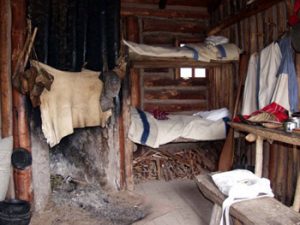 Today, the post is re-created down to the minute detail looking like the original 1804 post, but to go back in time, we must first go forward through the new Visitor Center.
Today, the post is re-created down to the minute detail looking like the original 1804 post, but to go back in time, we must first go forward through the new Visitor Center.
The Visitor Center, gift shop and exhibits opened in 2003. Inside, a 30-foot tall stone fireplace and a 24-foot birch canoe are centerpieces of the 10,400 square-foot building.
Once inside the exhibit room, we explore the exhibits showing the global economy of the fur trade back then, the work lives of those involved and the cross-cultural communication between the Ojibwe and fur traders required to establish and carry on the business of acquiring furs. Now having a better understanding of the fur trade business, we move outside and start down the trail toward the post. After a short walk, a large fence made from wooden poles comes into view. We enter through the two open large wooden gates.
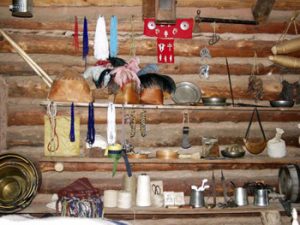 Once inside the post, the prominent building is the reconstructed six-room row house, measuring 77 feet long by 18 feet wide. We learn from one of the period-costumed re-enactors that the wooden fence surrounding the row house is a palisade – a wall created from upright poles stuck in the ground, measuring 100 feet by 61 feet, with defensive bastions in the north and south corners.
Once inside the post, the prominent building is the reconstructed six-room row house, measuring 77 feet long by 18 feet wide. We learn from one of the period-costumed re-enactors that the wooden fence surrounding the row house is a palisade – a wall created from upright poles stuck in the ground, measuring 100 feet by 61 feet, with defensive bastions in the north and south corners.
The row house is divided into five sections. Starting at the far end, we enter the doorway to the company store. It is open and we browse through the items in the store and soon start to experience what it was like living at a fur post in the early 1800s. The storekeeper tells us the Ojibwe would trade furs in return for goods such as axes, beads, iron tools, kettles, wool blankets and other supplies they needed.
The next section is the office. It is here where Sayer worked and kept the post’s books for the company. Lying on the desk are the simple tools of his trade from that era – a quill pen, ink-well and a bound book used to record the transactions.
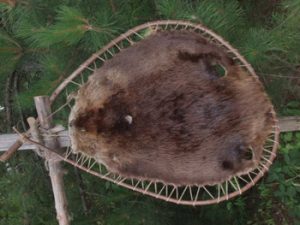 The remaining three areas are divided into two sleeping quarters and one living area. Each sleeping quarter has multiple beds stacked bunk-bed style and a small fireplace. Clothes are hung on the wall. The living/eating area is a room containing a hewn table with benches around it and a larger fireplace used for cooking. Re-enactors go about carrying out the daily duties of that era by keeping the post operating, preparing hides for use and shipment, preparing meals and blacksmithing.
The remaining three areas are divided into two sleeping quarters and one living area. Each sleeping quarter has multiple beds stacked bunk-bed style and a small fireplace. Clothes are hung on the wall. The living/eating area is a room containing a hewn table with benches around it and a larger fireplace used for cooking. Re-enactors go about carrying out the daily duties of that era by keeping the post operating, preparing hides for use and shipment, preparing meals and blacksmithing.
Outside the palisade, a small group of Ojibwe has an tepee encampment set up where they go about the daily work of scraping, stretching and drying furs in preparation for trade with the post.
As I walk back toward the Visitor Center, smelling the wood smoke, hearing the crackling of the fire and listening to sound of the activity happening, both in the Ojibwe camp and the post, it is easy for my mind to step back in time and suddenly, for an instant, I’m there – in 1804.
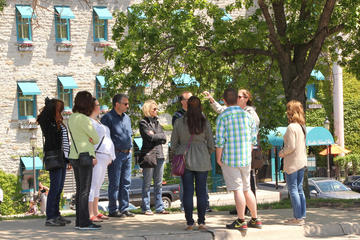
Historic Northeast Minneapolis Food Tour
If You Go:
Snake River Fur Post
Minnesota Historical Society
Northwest Journal – A Year in the Life of a Canoe Brigade
The Northwest Fur Post is operated by the Minnesota Historical Society and it makes a great day-trip from the Minneapolis-St.Paul area. Admission: $8 adults, $6 senior citizens, and $4 children ages 6-17. Free for children under age 6. School and group tours by reservation.
The hours of operation are: SUMMER (May 1 through Labor Day) 10 a.m. to 5 p.m. Monday through Saturday; noon to 5 p.m. Sunday. FALL (The day after Labor Day through Oct 31) Friday and Saturday, 10 a.m. to 5 p.m.; Sunday, noon to 5 p.m.
Phone: 320-629-6356
Location: 1.5 miles west of I-35 at exit 169 (Pine County Hwy. 7) near the town of Pine City, Minnesota
About the author:
Ron Kness is a travel writer/photographer with articles and photos published in various house publications, in-flight magazines and other media sources. Ron is keenly interested in the United States history from after the Revolutionary War through the Civil War.
All photos are by Ron Kness.
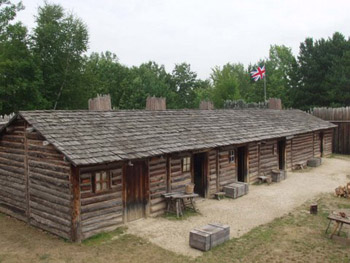


Leave a Reply
You must be logged in to post a comment.